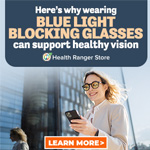
Thermography: A Safer Option for Breast Cancer Detection
Monday, November 12, 2007 by: Mary Laredo
Tags: breast cancer, thermography, health news
- CLOT SHOT PLANDEMIC UNFOLDING: Fibrous, rubbery clots caused by covid injections have prion-like seeding activity
- Widespread social and economic unrest: Steve Quayle issues urgent financial warning of imminent asset collapse in new interview with Mike Adams
- DEATH by VACCINE or face PRISON time: Canadian Freedom Convoy leaders CONVICTED for protesting forced vaccination during the Covid Plandemic
- How to detox from metals falling out of the sky
- Aerosolized bioweapons? Strange “diploid biomasses” falling out of the sky in Florida captured under the microscope
- How Israeli military-connected corporations are secretly controlling your online privacy
- How the peanut allergy epidemic was fueled by faulty science and institutional arrogance
- Kiss Your Genetic Privacy Good-Bye! 23andMe Gets Green Light to Sell Your Intimate Genetic Details to Anyone They Want
- Analysis: The coming economic collapse, a mass uprising and Trump's three secret weapons to halt the growing revolt
- Thimerosal is 50 percent MERCURY and NO it has NOT been removed from vaccines - that was a BIG FAT LIE the CDC told vax skeptics to keep them vaxxed up and dying
- “Rockefeller Medicine Men”: Today’s healthcare crisis stems from the creation of the American medical establishment
- Mike Adams releases country western hit single: Goin’ Back in Time is Comin’ Home
- EU takes aim at Elon Musk's X with potential $1 billion fine under Digital Services Act
- Global financial Ponzi scheme collapses in real time as markets plummet, Mike Adams and Steve Quayle warn of impending chaos
- European Court of Justice: Healthcare professionals who promoted or administered COVID-19 vaccines are CRIMINALLY LIABLE for any harm caused
- Defunding DEADLY mRNA jabs: Government funding for mRNA technology being scrutinized and sidelined until proven "safe and effective" for real
- New York governor signs controversial gun control measure, sparking Second Amendment concerns
- Washington State expands hate crime bill but ignores left-wing violence against Tesla owners
- Aerosolized bioweapons? Strange “diploid biomasses” falling out of the sky in Florida captured under the microscope
- European Court of Justice: Healthcare professionals who promoted or administered COVID-19 vaccines are CRIMINALLY LIABLE for any harm caused
- Newly released JFK files reveal Pentagon's role in creating Lyme disease and covid in the same lab
- Analysis: The coming economic collapse, a mass uprising and Trump's three secret weapons to halt the growing revolt
- FBI imposed gag order on agents to silence Hunter Biden laptop truth before 2020 election, new chat logs reveal
- Britain’s descent into police state censorship: Parents raided for questioning their daughter’s school system online
- “Project Aldrin”: Senate probes Meta's alleged censorship dealings with China
- Kiss Your Genetic Privacy Good-Bye! 23andMe Gets Green Light to Sell Your Intimate Genetic Details to Anyone They Want
- Oncologist warns of ‘terrifyingly aggressive’ cancers in children, linked to immune suppression from COVID vaccines
- Mike Adams releases country western hit single: Goin’ Back in Time is Comin’ Home
- Utah governor allows ban on LGBT pride flags in public buildings and schools, will take effect without his signature
- AI-powered forecasting model proves more accurate than traditional systems at predicting the weather
- When antibiotics are unavailable, natural ANTIMICROBIAL compounds become essential first line defenses against infection
- German researchers find link between mRNA vaccines and GENETIC CHANGES that precede CANCER and AUTOIMMUNE DISORDERS
- Defunding DEADLY mRNA jabs: Government funding for mRNA technology being scrutinized and sidelined until proven "safe and effective" for real
- The Health Ranger releases “Vaccine Zombie” song and music video, using AI-animated zombies for the music video
- Dr. Mary Talley Bowden drops bombshells about children being permanently damaged by mRNA jabs during Tucker Carlson interview
- The hidden war above: Chemtrails, HAARP and the battle for planetary control
- Newly released JFK files reveal Pentagon's role in creating Lyme disease and covid in the same lab
- California's social media censorship law struck down: A victory for free speech or a threat to online safety?
- The Health Ranger releases “Vaccine Zombie” song and music video, using AI-animated zombies for the music video
- Dr. Mike Yeadon releases 15-minute testimony - WATCH - about genocidal intent of COVID “vaccines”
- EPA advisor admits the agency is funneling billions to climate groups ahead of Trump’s return to White House
- Rep. Nancy Mace introduces bill to ban biological males from female facilities on federal property
- Mike Adams releases country western hit single: Goin’ Back in Time is Comin’ Home
- Florida takes a stand: DeSantis proposes permanent ban on mRNA vaccine mandates
- Sugarcane extract superior to cholesterol-lowering drugs?
- Survival 101: Effective EMF blocking techniques
- OpenAI whistleblower who dissented against how the company trained ChatGPT found dead
- CONSERVATIVES SOUND THE ALARM: Big Pharma and the Left trying to force $32 billion money grab from America’s seniors into year-end spending deal
- Pilots report mysterious lights 'moving at extreme speeds' across Oregon skies
- Attorney and TikTok influencer explains how he was offered hundreds of dollars to make false claims about Trump, Republicans
- Trump reverses course on Gaza plan, says “nobody is expelling Palestinians”
- Trump expected to choose Kelly Loeffler as his agriculture secretary even though she was caught INSIDER TRADING during COVID
- MEDICAL BOMBSHELL: FDA admits Covid mRNA 'Vaccines' CAUSE CANCER
- Marketing director responsible for WOKE Jaguar rebrand is also an LGBT activist who supports Black Lives Matter
- Red Cross issues warning to stop blood plasma donations from vaccinated people
- Scientists confirm: GENIUS brain function can be spontaneously unleashed in humans without any apparent cause
- EPA advisor admits the agency is funneling billions to climate groups ahead of Trump’s return to White House
- HYSSOP: What research reveals about the health benefits of this ancient holy herb
- Two containers with completed ballots fall out of truck in Florida
- Fully vaccinated about to see “tsunami” of illness and death, warns virologist
- Global leaders unite to clamp down on “misinformation” with UN-backed Cascais Declaration
- Newly released JFK files reveal Pentagon's role in creating Lyme disease and covid in the same lab
- BREAKING: 2025 NDAA authorizes mandatory military draft of WOMEN across America… as Pentagon pursues global NUCLEAR war with both Russia and China at the same time
- Michael Yon warns of a ZIONIST TAKEOVER in Trump’s second administration
- Ozempic and Wegovy weight loss drugs are injectable LIZARD VENOM PEPTIDES that may unleash a devastating wave of organ failure… side effects align with symptoms of SNAKE BITES
- BOMBSHELL: DNA testing kits are a SCAM to develop ethnic-specific bioweapons
- The Health Ranger releases “Vaccine Zombie” song and music video, using AI-animated zombies for the music video
- Israeli soldiers accused of even more torture and abuse in the West Bank
- These 13 countries just signed an agreement to engineer a global FAMINE by destroying food supply
- NASA admits that climate change occurs because of changes in Earth’s solar orbit, and NOT because of SUVs and fossil fuels
- RFK Jr. clears key hurdle: Sen. Susan Collins backs controversial HHS nominee, signaling a new era for health policy
- Sermon 30: How Jesus reveals Caesar’s FAKE CURRENCY and FALSE AUTHORITY
With toxic radiation, mammogram testing compresses sensitive breast tissue causing pain and possible tissue damage. To make matters worse, the false negative and false positive rates of mammography are a troubling 30% and 89% respectively.(1) Another concern is that many breast cancers occur below the armpits; however, mammography completely misses this auxiliary region, viewing only the breast tissue compressed between two plates of glass. Considering these drawbacks, breast thermography should be given closer consideration.
Thermography (also called thermology) is a little-known technique for breast cancer detection that’s been available since the 1960s. It’s non-invasive and non-toxic, using an infrared camera to measure thermal emissions from the entire chest and auxiliary regions. Cancerous tissue develops a blood supply to feed a growing tumor, and the abnormal blood vessel formations generate significantly more heat than the surrounding healthy tissue. The infrared camera detects the differences in heat emitted from abnormal tissue (including malignancies, benign tumors and fibrocystic disease), as compared to normal tissue. There is no physical contact with the patient, who stands several feet away from the camera while a technician takes a series of images.
A second set of images is taken following a “cold challenge”. The patient places her hands in ice cold water for one minute causing healthy tissue to constrict while the abnormal tumor tissue remains hot. The infrared scanner easily distinguishes the difference, and these images are compared with the first set for confirmation.
Thermography can detect abnormalities before the onset of a malignancy, and as early as ten years before being recognized by other procedures such as manual breast exam, mammography, ultrasound or MRI.(2) This makes it potentially life-saving for women who are unknowingly developing abnormalities, as it can take several years for a cancerous tumor to develop and be detected by mammogram. Its accuracy is also impressive, with false negative and false positive rates at 9% for each.(3) Thermography is also an effective way to establish a baseline for comparison with future scans; therefore, women should begin screening by the age of 25.
Although widely embraced by alternative health care practitioners, thermography’s obscurity in the mainstream means that too many women rely on mammograms as their only option. There are several reasons for thermography’s lack of support by the conventional medical community. Early thermal scanners were not very sensitive, nor were they well-tested before being used in clinical practice. This resulted in many misdiagnosed cases and its utter dismissal by the medical community. Since then the technology has advanced dramatically and thermography now uses highly sensitive state-of-the-art infrared cameras and sophisticated computers. A wealth of clinical research attests to its high degree of sensitivity and accuracy. In 1982, the FDA approved thermography for breast cancer screening, yet most of the medical establishment is either unaware of it or still associates it with its early false start. Since most women are also uninformed of the technology there is no pressure on the medical community to support it.
This author - who knows from first-hand experience the physical and emotional trauma of mammography as well as the passive and comforting accuracy of thermal scanning – would have been spared from years of radiation exposure with an earlier knowledge of thermography. The importance of education and awareness of this technology cannot be overstated.
When a thermographic report is negative, annual monitoring is essential to note any changes as early as possible. A positive report should be discussed with a health care practitioner as it may be necessary to follow-up with another detection method such as mammography or ultrasound to identify the exact location of the abnormality and to determine whether tissue biopsy is needed. If mammography is used to complement the thermal scan, it’s important to offset the affects of radiation prior to and following the procedure. Wheat grass juice, green super foods, or brown seaweed such as Modifilan are powerful detoxifiers.
Breast abnormalities and tumors are merely symptoms of imbalances within the body’s internal terrain that need to be identified and corrected. A thoughtful and careful look at diet, exposure to toxins, and lifestyle should be the first line of defense against any disease. This, and regular thermal screenings provide an effective arsenal against breast cancer. An internet search of thermography will locate qualified technicians in your area.
1. Saputo, MD. Len. Overview: Beyond Mammography. From his account of the “Breast Cancer Detection Demonstration Project: Five Year summary
report” CA: A Cancer Journal for Clinicians, Vol 32, 194-225, Copyright © 1982 by American Cancer Society.
2. International Academy of Clinical Thermology, www.iact-org.org
3. http://healthybreasts.info/ Summary from “Value and Interest of Dynamic Telethermography in Detection of Breast Cancer”, ACTA Thermographica,
Vol. 1, Num. 2, 89-96, 1976.
About the author
Mary Laredo is an artist, educator and gallery curator who lives and works in Detroit, MI. As a breast cancer survivor who shunned conventional treatment, she is writing a book about her experience with natural therapies and nutritional healing. Visit http://marylaredo.blogspot.comBreast cancer at FETCH.news
Get independent news alerts on natural cures, food lab tests, cannabis medicine, science, robotics, drones, privacy and more.
Take Action: Support Natural News by linking to this article from your website
Permalink to this article:
Embed article link: (copy HTML code below):
Reprinting this article:
Non-commercial use OK, cite NaturalNews.com with clickable link.
Follow Natural News on Facebook, Twitter, Google Plus, and Pinterest
Science News & Studies
Medicine News and Information
Food News & Studies
Health News & Studies
Herbs News & Information
Pollution News & Studies
Cancer News & Studies
Climate News & Studies
Survival News & Information
Gear News & Information
News covering technology, stocks, hackers, and more



"Big Tech and mainstream media are constantly trying to silence the independent voices that dare to bring you the truth about toxic food ingredients, dangerous medications and the failed, fraudulent science of the profit-driven medical establishment.
Email is one of the best ways to make sure you stay informed, without the censorship of the tech giants (Google, Apple, Facebook, Twitter, YouTube, etc.). Stay informed and you'll even likely learn information that may help save your own life."
–The Health Ranger, Mike Adams












































